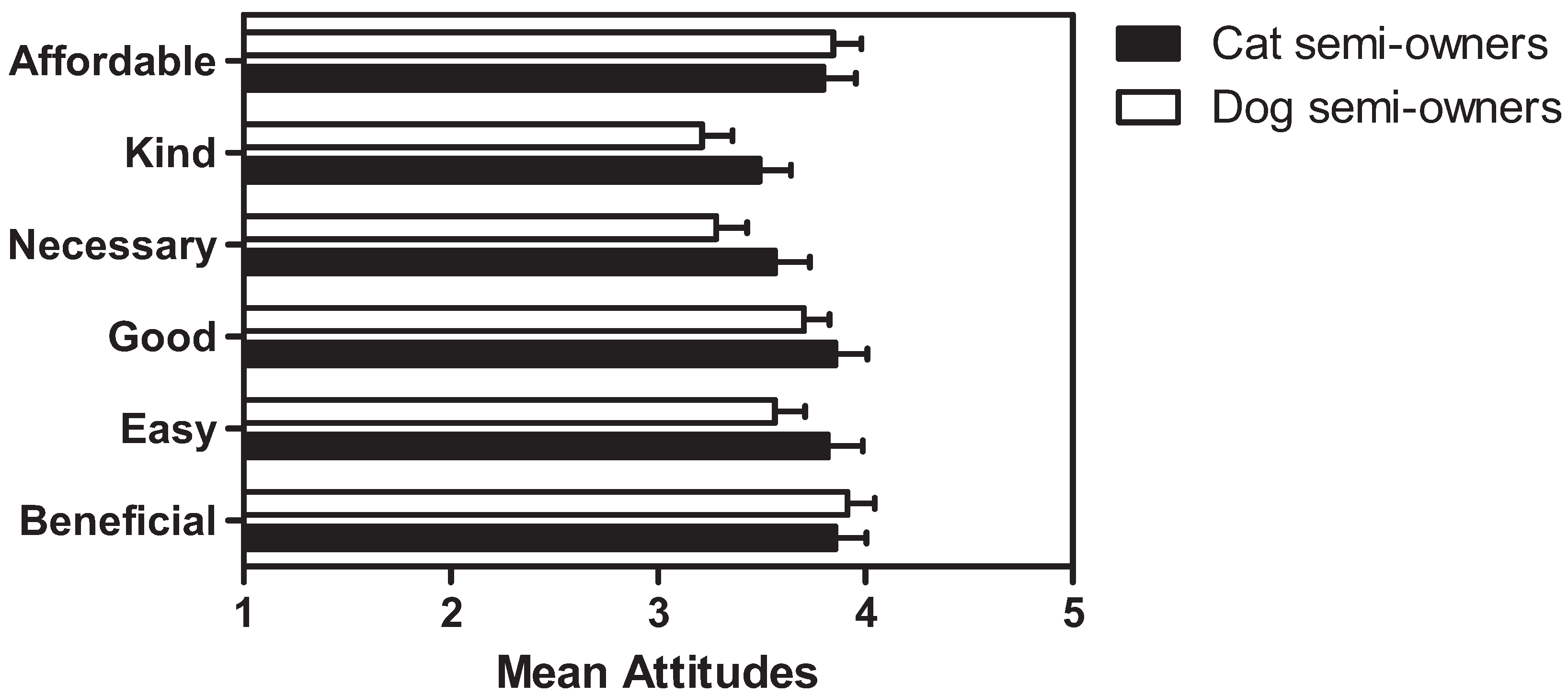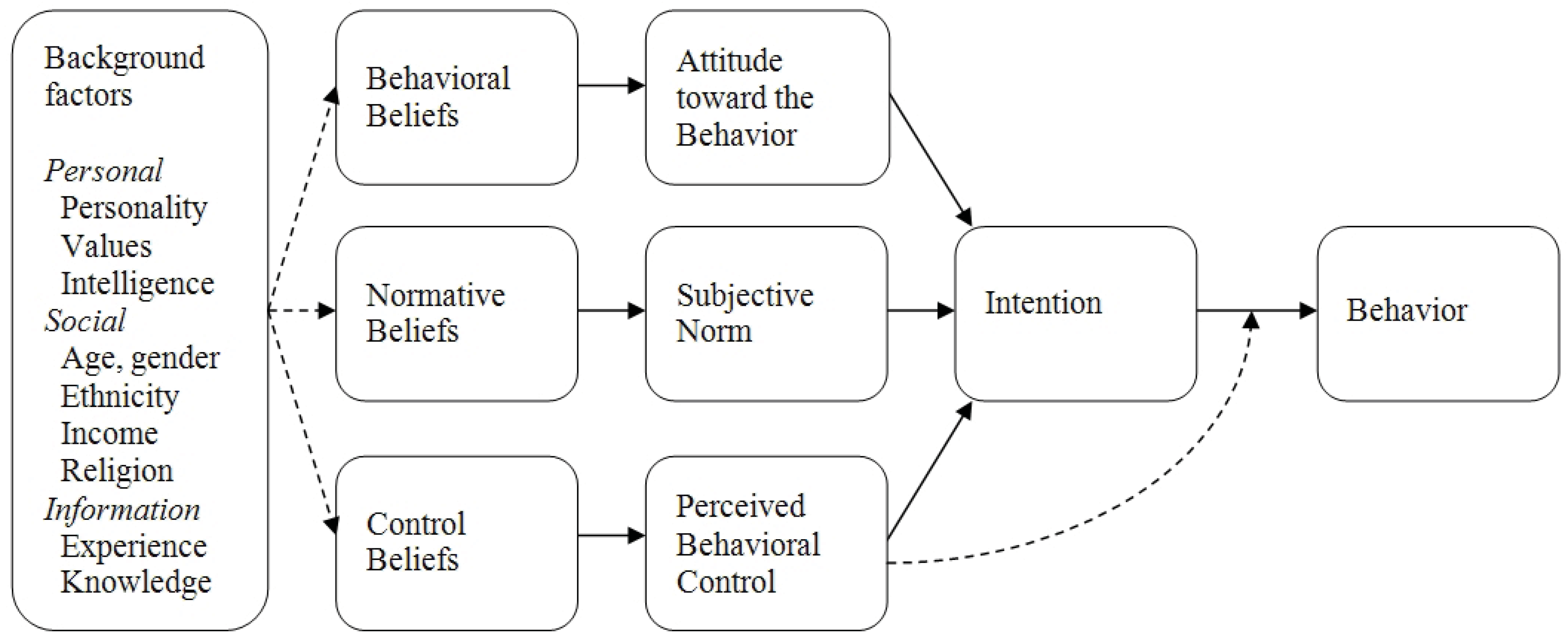3.1. Cat Semi-Ownership and Sterilisation
Of the entire sample (N = 494), 55 respondents (11.13%), comprising 18 males (32.7%) and 37 females (67.3%), indicated that they regularly interact with and care for a cat they do not own. Of these semi-owned cats, there were somewhat more females relative to males (52.7% vs. 47.3% respectively) and 36.4% wore collars. Most cat semi-owners did not think that they were the main person who looked after the cat (76.4%). In relation to ownership, 45.5% believed the cat was owned by someone, 30.9% believed the cat was unowned, and 23.6% were unsure. Only 7.3% the cats were known to be desexed (n = 4), with 60% known to be intact and 32.7% of semi-owners were unsure.
3.2. Dog Semi-Ownership and Sterilisation
In relation to semi-owned dogs, 71 respondents, comprising 23 males (32.4%) and 48 females (67.6%), indicated that they interact with and care for a dog they do not own; this represented 14.37% of the entire sample (N = 494). Most of the semi-owned dogs were male (59.2%) and did not wear collars (74.6%). Almost half of the dog semi-owners (49.3%) believed the dog was owned by someone else, 33.8% thought the dog was unowned and 16.9% were unsure. Most dog semi-owners did not believe that they were the main person looking after the dog (76.1%). Only 16.9% of semi-owners thought the dog had been desexed (n = 12), 66.2% indicated that the dog was intact and a further 16.9% were unsure.
Of the sample of semi-owners (n = 102), most (n = 73, 71.6%) also indicated ownership of a cat and/or a dog.
3.5. Beliefs Regarding Health and Behavioural Outcomes of Sterilisation
Cat (n = 55) and dog (n = 71) semi-owners were asked their beliefs about the health and behavioural outcomes of sterilisation for cats and dogs. As shown in
Figure 4, the findings indicated some positive (
i.e., health, companionship) and some negative (
i.e., frustrated, bored, territorial, aggressive) beliefs about sterilisation outcomes. Semi-owners believed that sterilised animals become less energetic, but not overweight. There were no significant differences between cat and dog semi-owners.
Figure 4.
Mean beliefs (± SEM) regarding the outcomes of sterilisation in cat (n = 55) and dog (n = 71) semi-owners (1 = strongly disagree, 5 = strongly agree).
Figure 4.
Mean beliefs (± SEM) regarding the outcomes of sterilisation in cat (n = 55) and dog (n = 71) semi-owners (1 = strongly disagree, 5 = strongly agree).
3.8. Animal Empathy Scale
Total mean animal empathy scores in semi-owners (n = 102) ranged from 45 to 76.9, with a mean of 58.13 (SD = 8.05), indicating a tendency towards animal empathy. Animal empathy was significantly higher in semi-owners compared with non-semi-owners (n = 392, M = 54.53, SD = 5.87), t(492) = 5.07, p < 0.001. Within the sample of semi-owners (n = 102), cat semi-owners (n = 31, M = 55.03, SD = 6.62) had less empathy towards animals than dog semi-owners (n = 47, M = 59.27, SD = 7.87) or cat/dog semi-owners (n = 24, M = 59.87, SD = 9.20), F(2,101) = 3.50, p < 0.05.
3.9. Personality, Attitudes and Empathy
The TIPI was used to examine personality characteristics in semi-owner (n = 102)
vs. non-semi-owner (n = 392) groups. Mean scores for both groups were around the midway point of the 5-point scale for each of the personality domains (extraverted, agreeable, conscientious, emotional stability and openness). The results showed that semi-owners were significantly more open to experience than non-semi-owners,
t(492) = 3.46,
p < 0.001. Pearsons correlation coefficients were used to identify associations between personality, attitudes and empathy in semi-owners (n = 102) (see
Table 5). With the exception of extraversion, all personality domains were associated with attitudes towards desexing and animal empathy.
Table 5.
Pearson’s Correlation Coefficient between personality, attitudes and empathy in semi-owners (n = 102).
Table 5.
Pearson’s Correlation Coefficient between personality, attitudes and empathy in semi-owners (n = 102).
| | Extravert | Agreeable | Conscientious | Emotional Stability | Openness |
|---|
| Attitudes towards desexing dogs | 0.07 | 0.12 * | 0.15 ** | 0.06 | 0.12 ** |
| Attitudes towards desexing cats | 0.01 | 0.12 ** | 0.13 ** | 0.11 * | 0.12 ** |
| Animal empathy | −0.08 | 0.17 ** | 0.13 ** | −0.11 * | 0.17 ** |
3.10. Intentions to Desex Semi-Owned Cats and Dogs in the Future
The findings revealed low intentions for cat (Mean = 2.12, SD = 1.14) and dog (Mean = 1.17, SD = 0.99) semi-owners to sterilise in the near future; differences between groups were not significant. In total, 66.7% of cat semi-owners and 79.7% of dog semi-owners strongly disagreed or disagreed with the statement “I intend to desex this cat/dog in the near future”.
Point biserial correlations failed to identify any associations between demographic factors and intentions to sterilise semi-owned cats and dogs in the near future (
p > 0.05). There was an inverse association between intentions to desex semi-owned dogs and agreeableness (
r = −0.37,
n = 59,
p < 0.01) and conscientiousness (
r = −0.26,
n = 59,
p < 0.05), but apart from these, personality and animal empathy were not associated with intentions to sterilise semi-owned animals in the future (
Table 6). In general, intentions to sterilise semi-owned cats and dogs were associated with TPB variables including attitudes, religious beliefs, norms and perceived behavioural control variables (e.g., agency, financial constraints, access to veterinarians, commitments).
Table 6.
Point Biserial Correlation Coefficient between intentions to sterilise and psychosocial factors.
Table 6.
Point Biserial Correlation Coefficient between intentions to sterilise and psychosocial factors.
| Factor | Intentions to sterilise |
|---|
| Semi-owned Dog (n = 59) | Semi-owned Cat (n = 51) |
|---|
| Personality | Extraversion | 0.13 | −0.20 |
| Agreeable | −0.37 ** | −0.11 |
| Conscientious | −0.26 * | −0.03 |
| Emotional Stability | −0.17 | 0.09 |
| Openness | −0.10 | −0.11 |
| Animal empathy | −0.02 | −0.19 |
| Beliefs | Independent | −0.13 | −0.29 * |
| Education | −0.21 | −0.04 |
| Desexing outcome beliefs | 0.08 | −0.02 |
| Theory of Planned Behaviour | Attitude: positive | 0.30 * | 0.22 |
| Norms | 0.66 ** | 0.43 ** |
| Religion | 0.55 ** | 0.54 ** |
| PBC 1 – agency | 0.54 ** | 0.61 ** |
| PBC – access | 0.53 ** | 0.50 ** |
| PBC – finances | 0.36 ** | 0.36 ** |
| PBC – commitments | 0.44 ** | 0.50 ** |
| PBC – arrange | 0.49 ** | 0.37 ** |
The HMR model for intentions to sterilise semi-owned dogs in the future was highly significant F(9, 48) = 11.45,
p < 0.001. Respondents living in Southern Thailand (
β = −0.31) and those that were agreeable (
β = −0.26) were less likely to hold intentions to sterilise semi-owned dogs in the future. Conversely, respondents who perceived normative pressure to sterilise (
β = 0.46), perceived sterilizing to be consistent with his/her religion (
β = 0.40), considered the decision to sterilise entirely theirs to make (
β = 0.42), believed that sterilisation was affordable (
β = 0.21), but that financial constraints prevented them from sterilising (
β = 0.27) and did not believe that they could make arrangements to sterilise if they wanted to (
β = −0.48), were more likely to hold intentions to sterilise. These factors accounted for 62.3% of the variance in intentions to sterilise semi-owned dogs in the future (see
Table 7).
A significant HRM model was also achieved for intentions to sterilise semi-owned cats in the future, F(7, 42) = 21.59,
p < 0.001. Respondents who had only attained a Primary school level of education (
β = −0.32) and that held the belief that they could not arrange to have the cat desexed if they wanted to (
β = −0.26) were less likely to intend to sterilise semi-owned cats in the near future. Conversely, respondents who perceived normative pressure to sterilise (
β = 0.28), believed that the behaviour was consistent with their religious beliefs (
β = 0.20), believed that the decision to desex was entirely theirs to make (
β = 0.62), and that personal commitments prevent desexing (
β = 0.36) were more likely to intend to sterilise semi-owned cats in the future. These factors explained 74.6% of the variance in intentions to sterilise semi-owned cats in the near future (
Table 7).
Table 7.
Hierarchical Multiple Regression Model for factors predicting intentions to sterilize in cat and dog owners and semi-owners.
Table 7.
Hierarchical Multiple Regression Model for factors predicting intentions to sterilize in cat and dog owners and semi-owners.
| | Predictors | b | SE | β | t | Adjusted R2 |
|---|
| Semi-owned dog | South | −0.94 | 0.29 | −0.31 ** | −3.21 | 0.62 |
| Agreeable | −0.33 | 0.13 | −0.26 * | −2.65 |
| Norms | 0.44 | 0.14 | 0.46 ** | 3.04 |
| Religion | 0.51 | 0.16 | 0.40 ** | 3.12 |
| PBC 1 -decision | 0.35 | 0.11 | 0.42 ** | 3.14 |
| PBC-finances | 0.23 | 0.10 | 0.27 * | 2.41 |
| PBC-arrange | −0.37 | 0.14 | −0.48 * | 2.67 |
| Attitude-affordable | 0.17 | 0.08 | 0.21 * | 2.08 |
| Semi-owned cat | Education-Primary | −0.92 | 0.23 | −0.32 ** | −3.93 | 0.75 |
| Norms | 0.30 | 0.11 | 0.28 * | 2.90 |
| Religion | 0.26 | 0.12 | 0.20 * | 2.31 |
| PBC-decision | 0.59 | 0.10 | 0.62 ** | 5.92 |
| PBC-commitments | 0.40 | 0.09 | 0.36 ** | 4.42 |
| PBC-arrange | −0.24 | 0.10 | −0.26 * | −2.32 |









